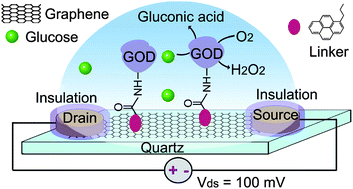Graphene, a single-atom-thick and two-dimensional carbon material, has attracted great attention recently. Because of its unique electrical, physical, and optical properties, graphene has great potential to be a novel alternative to carbon nanotubes in biosensing. We demonstrate the use of large-sized CVD grown graphene films configured as field-effect transistors for real-time biomolecular sensing. Glucose or glutamate molecules were detected by the conductance change of the graphene transistor as the molecules are oxidized by the specific redox enzyme (glucose oxidase or glutamic dehydrogenase) functionalized onto the graphene film. This study indicates that graphene is a promising candidate for the development of real-time nanoelectronic biosensors.
